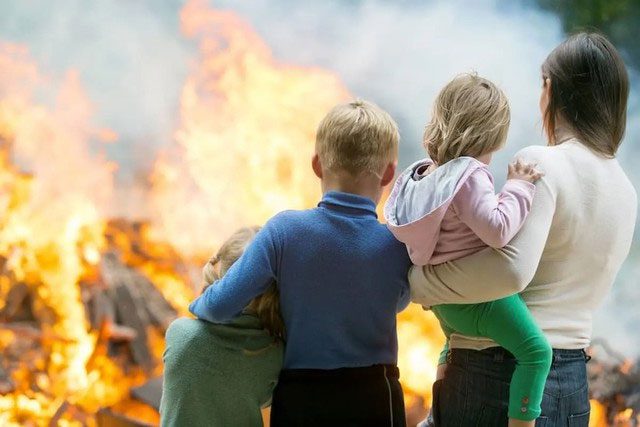According to information regarding the mini-apartment fire in Hanoi on September 12, 2023, there were 56 fatalities (including 16 children) and 37 injuries (including 9 children).
Globally, there have been several incidents resulting in child casualties, such as the 2022 apartment fire in New York, USA, which claimed 19 lives, including 9 children, and the 2018 shopping mall fire in Russia, which resulted in 64 deaths, including 11 children, along with many injured children.
This highlights that during fire incidents, regardless of their scale, children are often the most vulnerable. The primary cause of death among victims is asphyxiation – due to inhaling toxic gases, primarily carbon monoxide (CO) along with other gases such as carbon dioxide (CO2) and hydrogen cyanide, as well as injuries (from victims falling or jumping from heights).

The primary cause of death among victims of the fire is asphyxiation. (Illustrative image).
When fires occur, children often panic, run around, and cry, making them more susceptible to inhaling toxic smoke. CO is a colorless, odorless toxic gas produced by the incomplete combustion of organic compounds due to insufficient oxygen. CO competes with oxygen to bind to hemoglobin in the blood, causing a state of hypoxemia.
One of the organs affected by CO poisoning is the nervous system, and children who survive a fire may face neurological complications. This is a concern for parents, especially since children’s brains and nervous systems are still developing during this stage. Neurons are particularly vulnerable to hypoxemia.
Currently, there are very few studies in medical literature focusing on children. A group of pediatricians from Soroka University in Israel reported a case of a child suffering from neurological complications following CO poisoning in Frontiers in May 2022. The child was in a coma due to CO poisoning. After 5 days of treatment, the child recovered and was discharged without any neurological decline.
However, by the eighth day after returning home, the child exhibited symptoms of headaches, numbness, weakness in the limbs, and seizures. The child returned to the hospital and underwent an MRI, which showed no abnormalities; however, an EEG revealed epileptic waves in the brain. After 19 days, the child experienced decreased vision in both eyes due to retinal damage. After 2 months of CO poisoning, the child reported memory loss, some improvement in vision, and occasional seizures. Seven months later, neurological abnormalities became more pronounced. The MRI showed brain atrophy and white matter damage.
Thus, the child suffered from late neurological complications following CO poisoning. Symptoms can vary widely, including memory loss, seizures, epilepsy, behavioral and mood disorders (such as aggression, irritability, or shyness and fearfulness), or vision loss as seen in the case mentioned. The incidence of children experiencing late neurological complications ranges from 3% to 17%.
Another study published on Science Direct in 2017, conducted at a medical center in Taiwan from 2002 to 2010, involved 81 children of various ages who suffered from CO poisoning ranging from mild (headaches, dizziness, nausea, etc.) to severe (coma). It found that 12 children (approximately 15%) developed late neurological complications, primarily manifesting as epilepsy, seizures, cognitive impairment, personality changes, and weakness in the limbs.
These cases demonstrate that CO poisoning in children, regardless of severity, leaves lasting neurological effects that impact their development and future.
Therefore, adults must take proactive measures to prevent CO poisoning in children, and children should be equipped with knowledge to respond to fire and explosion situations.
For children recovering from CO poisoning (due to fire accidents or exposure to kitchen smoke, charcoal, gas, etc.), parents need to closely monitor their children to promptly identify any abnormal signs.


















































